Estrategias de trading para respaldar tu toma de decisiones
Explora técnicas prácticas para ayudarte a planificar, analizar y mejorar tus operaciones.


Most traders understand EA portfolio balance through the lens of traditional risk management — controlling position sizes, diversifying currency pairs, or limiting exposure per trade.
But in automated trading, balance is about deliberately constructing a portfolio where different strategies complement each other, measuring their collective performance, and actively managing the mix based on those measurements.
The goal is to create a “book” of EAs that can help diversify performance over time, even when individual strategies hit rough patches.
A diversified mix of EAs across timeframes and assets can, in some cases, reduce reliance on any single strategy. This approach reduces dependency on any single EA’s performance, smooths your overall equity curve, and builds resilience across changing market conditions.
It’s about running the right mix, identifying gaps in your coverage, and viewing your automated trading operation as an integrated whole rather than a collection of independent systems.
Basic Evaluation Metrics – Your Start Point
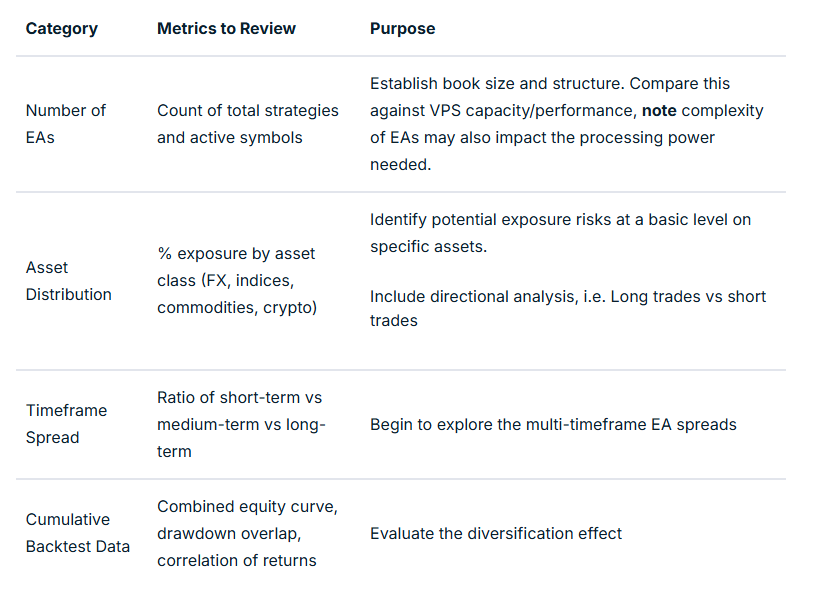
Temporal (timeframe) Balancing
When combined, a timeframe balance (even on the same model and instrument) can help flatten equity swings.
For example, a losing phase in a fast-acting M15 EA can often coincide with a profitable run in an H4 trend model.
Combining this with some market regime and sessional analysis can be beneficial.
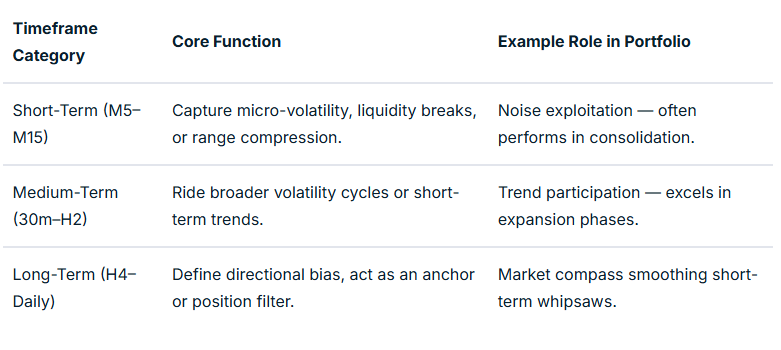
Asset Balance: Managing Systemic Correlation Risk
Running five different EAs on USDJPY might feel diversified if each uses different entry logic, even though they share the same systemic market driver.
But in an EA context, correlation measurement is not necessarily between prices, but between EA returns (equity changes) relating to specific strategies in specific market conditions.
Two EAs on the same symbol might use completely different logic and thus have near-zero correlation.
Conversely, two EAs on a different symbol may feel as though they should offer some balance, but if highly correlated in specific market conditions may not achieve your balancing aim.
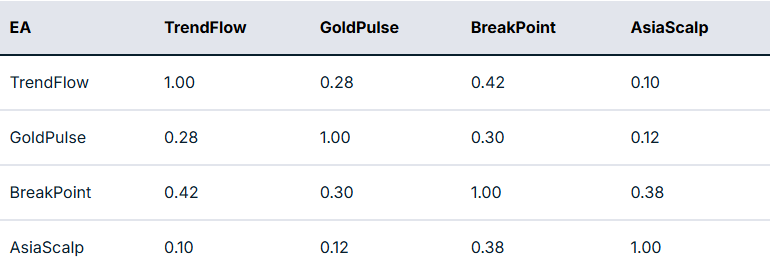
In practical terms, the next step is to take this measurement and map it to potential actionable interventions.
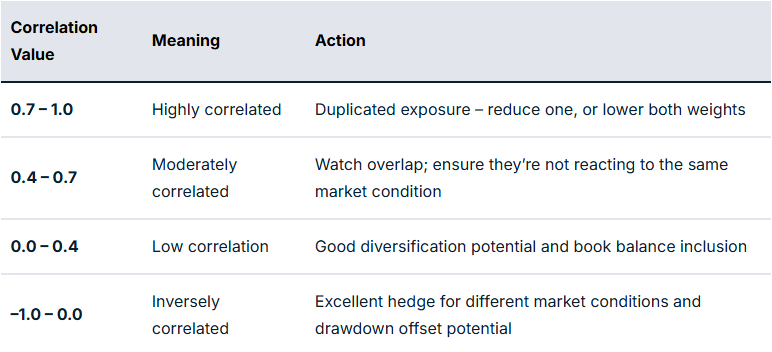
For example, if you have a EURUSD Trend EA and a GBPUSD Breakout EA with a correlation of 0.85, they are behaving like twins in performance related to specific market circumstances. And so you may want to limit exposure to some degree if you are finding that there are many relationships like this.
However, if your gold mean reversion EA correlates 0.25 compared to the rest of your book, this may offer some balance through reducing portfolio drawdown overlap.
Directional and Sentiment Balance
Markets are commonly described as risk-on or risk-off. This bias at any particular time is very likely to impact EA performance, dependent on how well balanced you are to deal with each scenario.
You may have heard the old market cliché of “up the staircase and down the elevator shaft” to describe how prices may move in alternative directions. It does appear that optimisation for each direction, rather than EAs that trade long and short, may offer better outcomes as two separate EAs rather than one catch-all.
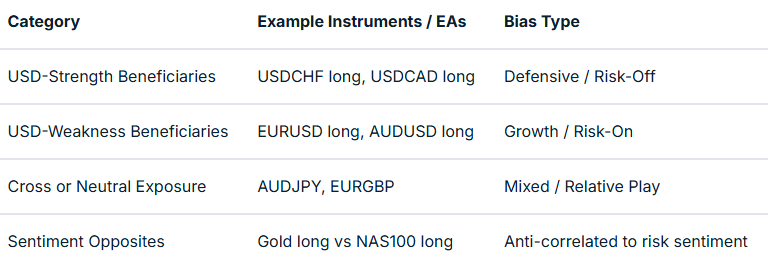
Market Regime and Volatility Balance
Trend and volatility states can have a profound impact on price action, whether as part of a discretionary or EA trading system. Much of this has a direct relationship to time of day, including the nature of individual sessions.
We have a market regime filter that incorporates trend and volatility factors in many EAs to account for this. This can be mapped and tested on a backtest and in a live environment to give evidence of strategy suitability for specific market conditions.
For example, mean reversion strategies may work well in the Asian session but less so in strongly trending markets and the higher volatility of the early part of the US session.
As part of balancing, you are asking questions as to whether you actually have EA strategies suited to different market regimes in place, or are you using these together to optimise book performance?
The table below summarises such an approach of regime vs market mapping:
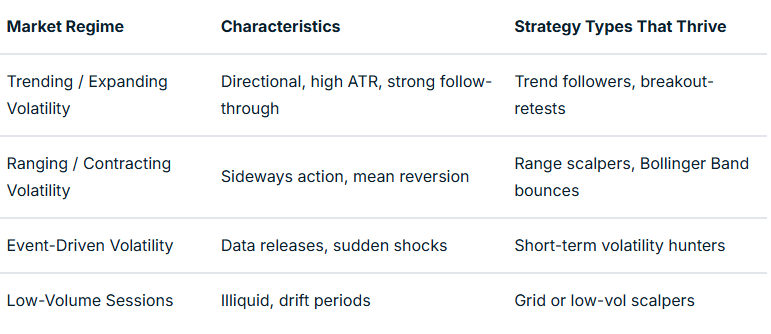
Multi-Level Analysis: From Composition to Interaction
Once your book is structured, the challenge is to turn it into something workable. An additional layer of refinement that turns theory and measurement into something meaningful in action is where any difference will be made.
This “closing the circle” is based on evidence and a true understanding of how your EAs are behaving together. It is the step that takes you to the point where automation can begin to move to the next level.
Mapping relationships with robust and detailed performance evaluation will take time to provide evidence that these are actually making a difference in meeting balancing aims.
To really excel, you should have systems in place that allow ongoing evaluation of the approaches you are using and advise of refinements that may improve things over time.
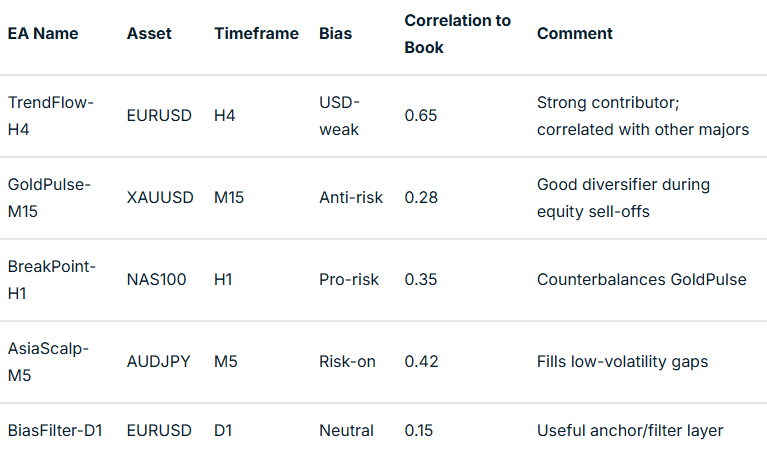
What Next? – Implementing Balance in Practice
Theory must ultimately translate into an executable EA book. A plan of action with landmarks to show progress and maintain motivation is crucial in this approach.
Defining classification tags, setting risk weights, and building monitoring dashboards are all worth consideration.
Advanced EA traders could also consider a supervisory ‘Sentinel’ EA, or ‘mothership’ approach, to enable or disable EAs dynamically based on underlying market metrics and external information integrated into EA coding decision-making.
Final Thoughts
A balanced EA portfolio is not generated by accident; it is well-thought-out, evidence-based and a continuously developing architecture. It is designed to offer improved risk management across your EA portfolio and improved trading outcomes.
Your process begins with mapping your existing strategies by number, asset, and timeframe, then expands into analysing correlations, directional bias, and volatility regimes.
When you reach the stage where one EA’s drawdown is another’s opportunity, you are no longer simply trading models but managing a system of EA systems. To finish, ask yourself the question, “Could this approach contribute to improved outcomes over time?”. If your answer is “yes,” then your mission is clear.
If you are interested in learning more about adding EAs to your trading toolbox, join the new GO EA Programme (coming soon) by contacting [email protected].


Those of you who have attended any of our LIVE Inner Circle education sessions, or participated in our courses, will know that a regular theme covered is the importance and benefits of measuring your trading. One of the key tools we often discuss is the use of a trading journal. For th ose of you less familiar with this as a concept, a trading journal is a method through which you record your decisions and actions on all trades you enter for a specific period (often a month at least).
This allows you not only to see the dollar performance of individual trades but more importantly to make judgements on: a. How well (or otherwise) you are following your trading plan; b. How well (or otherwise) your plan as a whole, and its specific components are serving your trading results.
Subsequently, you are then able to amend as necessary either your behaviour, your plan components, or indeed both with “hard” evidence. Many would suggest that this is a crucial system in any trader’s development. One of the common questions we are asked relates to the set up and contents of such a journal.
Quite simply, your aim should be to measure all aspects of the trade set up, entry and ultimately exit decisions. Such information could be recorded on a spreadsheet, a word document or even in a notepad for example. To help you kickstart your journaling process, the download attached to this article gives an example of the detailed information you could choose to collect.
It is easily adaptable to any trading vehicle should you be trading Forex, index CFDs or Share CFDs. Simply click below for access to your pdf download. trading journal blueprint If you would like to know more about how we can help your trading learning journey, why not join our Facebook “Inner Circle” group for weekly educational content, or there is also our “Next Steps: course (see image link on the right) where you can access a full video course including a specific session on journaling and an example template to download. One last thing…find the concept of “Blueprints” useful?
If so drop an email to [email protected] and let us know and we can develop some more. Trade Safe You can find additional forex education resources here. For information on other trading tools, see our Autochartist, Genesis for MetaTrader, VPS for MetaTrader and a-Quant information pages.


There are few long-term successful traders that at some stage have not suffered a major capital drawdown on their account at some stage. For whatever the reason the major factor as to whether you continue and get back to “winning ways” or continue to see further drawdowns is what you do next. Unfortunately, there are “traps” that such a set of circumstances can lead to, your aim, if this should happen to you is to avoid these.
This article aims to outline these to assist in developing awareness and assist in your “what happens next” thinking and actions. Trap 1 – Abdicate responsibility It is a natural human response when things go wrong to look for someone/something to blame. This is far easier emotionally to deal with than admitting that you have behaved, through actions, in a way that has contributed to a negative outcome.
Although it may be true that certain market conditions, or “trump tweets”, or economic announcements may all contribute to a significant market price movement, the majority of major capital drawdowns in reality occur over a number of trades and of course you have made the choice to trade and as if not more importantly when to exit any trades you have taken. The reality is of course, that unless you accept 100% that trading action is YOUR choice and that YOU are responsible for your trading results then you are unlikely to move forward and may indeed see further capital drawdowns on your trading account. Accepting this reality, gives you the drive to avoid the other potential traps and put the right things in place to reduce the likelihood of it happening again.
Trap 2 – Fail to explore WHY it happened? Beyond accepting responsibility one of your first tasks is to examine potential and subsequently actual factors that may have contributed. Commonly these can all come under the following: a.
You didn’t know what you were doing due to a knowledge gap b. You didn’t have an evidence-based (i.e. you have tested it and refined accordingly) specific comprehensive trading plan that guided your actions c. You didn’t follow your trading plan d.
Your trading system is comprehensive and sufficiently specific but doesn’t work and needs reviewed i.e. a new set of entry/exit criteria The temptation is, and many traders will go straight to ‘d’ of the above, but again arguably there is an element of “finger pointing” rather than taking responsibility. The reality is that of the four factors above the latter is the most unlikely cause. Being honest in your review is critical.
Such an honest review will give you clear guidance on which factor(s) you should focus on working on. Trap 3 – ‘Revenge’ trading Although this is a term bandied around frequently, let us delve beyond the ‘beermat psychology’ and look a little closer at what this may mean. In essence, the underlying emotional motivation is to get back to where you were before in terms of your account capital.
Commonly this thinking is backed by “desperation”, subsequently influencing actions that often bear little resemblance to good trading practice. In action, you may see: • Taking trades when there is no clear set up • Partial or complete ignoring of any trading plan • Inappropriate actions further trades go against you (e.g. finding reasons to stay in future trades when there is an exit) • Trading higher position sizing that you previously had • Trading each small market move, taking a reverse position even on a trend pause. • Looking to trade tighter and tighter timeframes These of course may significantly contribute to further losses as this emotional rather than system- based trading takes a stronger and stronger hold on your actions. Logically, the following may be more appropriate: • Give yourself some breathing space to properly review …STOP trading while you complete this (As described above) • Although easy to say and not so easy to accept the reality is that your account capital is what it is now, not what it was.
There was, for many in this situation, a time in your trading where whatever your capital level, your aim was to increase whatever that level was and put actions in place to give yourself the best chance of that happening. Ultimately, even if you strayed from this, developing consistency in appropriate trading plan actions and measurement are accepted by most traders as the way to make this happen over time. So, you need to press the “RESET button”, accept it as it is, and have the goal that through returning to that good trading practice consistently, and filling the gaps you need to.
Making this your goal rather than a dollar figure, may give yourself the chance to build capital not just to its previous level but beyond. Let it go! And do the right things from here I guess is the bottom-line message.
Trap 4 – Position size according to your previous rather than current account level This final trap for discussion in this article may seem obvious on the surface, but may either be a symptom of the previous point or something that is overlooked (unless of course inappropriate position sizing was one of the root causes of a major drawdown which you will discover in your review). It is crucial, and hence why we make special reference to it here, that you have a set risk level, usually expressed as a % of your account capital. This will differ from trader to trader but is comply between the 1-3% level as an example.
This determines lot/contract size (dependent on what you are trading) for any individual trade and combined with “stop loss” placement is a critical part of your risk management now and going forward. You need to recalculate what this is for you with reference to your NEW account size and factor this into your decision making, even if this means you are trading smaller amounts for now. In summary, major trading drawdowns are upsetting, and although not common often create additional ‘traps’ which may worsen what has happened to your trading capital.
And finally... Although perhaps of little consolation that many, many traders who now have sustained success, will have gone through this like you, the difference between what happens next and for your trading account in years to come, to your account is likely to be as a result of what you do next. You have choices to make but avoiding the above four traps described may perhaps assist in ultimately getting to where you want to be with your trading going forward.


Look, we get it… the thought of making money from the financial markets is appealing to the newcomer (and even experienced trader). Appealing enough to invest some time (often a great deal) and some money (often a great deal). At this stage, it is “interesting” (even exciting), but NOT committed.
You may even have been told it is easy if you do x,y,z or use this magical indicator, by the plethora of “gurus” simple clambering to relieve you of even more of your cash for that magical “holy grail” of approaches. We are still at ‘interesting’ not committed. The interest or motivation that drives you to this point is clear, you may even have begun to plan in your mind how you are going to spend your winnings, work less, live the dream.
Intangible, far-off pipe dreams are easy to contemplate and the market is going to pay for it!. We can imagine ourselves as some heroic ninja trader magically just making it happen (and some do magically create results on a ‘doesn’t really matter’ demo account). YES!
Still, this is still just ‘interesting’ not yet committed. However, when we commit to the daily practice of trying to put in place those micro-make-it-happen steps… this dream begins to fade. It’s replaced by the cold realization that there is some work… some hard work to be done.
That’s not what you subscribed to with that early interest is it, it should be easy to make money, shouldn’t it? What most traders do... Rather than engaging (volition) in this hard work, we choose to try to short-cut.
This has two logical outcomes: 1. Firstly, it continues to maintain our interest..no more. 2. Secondly, it is unlikely to make us any money trading.
We jump from program to program, indicator to indicator, vehicle to vehicle, read multiple articles, participate in forums, and yet the two logical outcomes above from our “interest” are still the case. There is no real point in banging on about psychology this and discipline that, we could point you in the direction of “7 things you can do to alter your trading results”, put ten other game-changing articles in front of you but nothing may change. That is, nothing will change unless you are prepared, that’s REALLY prepared, absolutely COMMITTED to making it happen..simple!
You could learn and have the system and tools to have sustainably great results, measure aspects of your trading so you can work out what might be going on with your behaviour, and yet even these may make no difference to the majority of the trading population. So, what is the difference between the “norm” who wish they had on-going positive trading results and the others who really do? Quite simply it is the level of commitment they are prepared to put in.
It moves beyond just interested. Are you ready to take this step? So, what do we mean by commitment?
Commitment is not: 1. Knowing some stuff 2. Doing some stuff 3.
Believing some stuff can happen “Some” is NOT good enough! Pe riod! Commitment is: 1.
Seeking out knowledge that will make a difference and learning it to the point where it becomes an integral part of you as a trader and the systems you develop and actually use. 2. Doing ALL of the right things on a consistent basis 3. Developing a passionate belief that something good could happen in your trading is replaced by the certainty that you can have sustained results that only evidence can provide.
So let’s cut to the chase..how committed are you? It easy to evaluate, just look at your behaviours… 1. Are you seeking out real learning that can make a difference in what you are doing or taking the short cut in the information you have (or can have access) to, and trying to replace that with a different indicator, strategy etc? 2.
Are you doing the right things ALWAYS or just when things go well (or not so well) – which starts of course by learning what the right things are? 3. Pssst! Here is a secret…You will never find the evidence to create that certainty that will keep you “safe” in those trickier market times unless you actually invest the commitment to measure what is happening and make sure these are the right things to measure (and this is not just trade profit/loss!).
There are few things more motivating than being able to provide some evidence of success. So how does what are currently doing stand up when you look at those three behaviours? The real trading EDGE We have heard all of the excuses, all of the reasons, every “my homework was eaten by the dog” story that it is possible to hear.
The reality is that trading success thing is within you and the level to which you are prepared to commit. The striving for a “trading edge”, which we will define as having an advantage over other market participants, is yours for the taking but only if you start by taking that interest and trade-changing commitment. It all starts with accepting what you are doing now..be honest… Removing all of the reasons “why not”, looking at your behaviour and ask yourself are you really committed?
We can do my part, give those who are committed the support, the learning programmes (see ‘First Steps’, ‘Next Steps’ and ‘Inner Circle’) that aim to fill gaps in knowledge, but with the “C-word”, which is your part, that is when good things can happen in your trading. So, Let’s finish with a mission (as it is these that are at the basis of making sure your commitment has the right focus) So ask the following questions and, of course, commit to following through on the following: 1. What can you learn that you don’t/partially know that could make the difference?
List your top three and seek out the answers (YES! We can help see ) 2. What are you not doing now that you know would contribute to your trading, even if it seems hard to start?
It may be to develop a COMPREHENSIVE trading plan, starting a journal etc. 3. What are you going to measure that may offer some evidence that you can REALLY do this! One last bit of good news…you CAN make the choice NOW whether you stay interested or becoming committed.
That the easy bit and your first vital step. Trade safe and exercise your choice to commit.




Invariably, the motivation to look at adding another technical indicator is a belief that your trading results, and the system that creates these, could be improved. As traders, we are bombarded with information relating to the use of technical indicators to guide decision making in our entry and exit decisions. Such information can be “persuasive” in making a change but as you are responsible for your trading decisions and subsequent results, it seems logical to start the process by asking the question “is it the right time for me to explore the use of another indicator?”.
The aim of this article is to highlight the FOUR critical questions you should ask of yourself first. 1. Am I REALLY trading my existing system NOW? As previously referenced, the major impetus for considering adding an indicator is to improve results when trading an existing system.
You can only make the judgement of any improvement if you both have a comprehensive system that specifies entry/exit/position sizing as a minimum AND are actually trading this. Potential trading actions The reality for most traders is that they fall down on one or both of these two CRUCIAL factors. Honesty with what you are doing now backed up with the evidence of journaling will give you the answer to this.
If these resonate with you, logically addressing these should be your priority. Without this, you are not able to make that judgement and hence adding another indicator is far less likely to impact positively on results. 2. Is adding another indicator the ONE major thing that is going to make the most difference to my trading results NOW or is there something else I should invest my energy on?
We have already specified two potential priorities in the previous point with reference to your trading plan and adherence to it. Also, we referenced the issue of evidence through journaling. As this is not only crucial for the above point, it is a vital part of your review process should you choose to investigate the use of a new indicator.
So again, could be viewed as a priority. Finally, addressing your knowledge relating to trading may be more important for you now. Not only are we referring to general trading learning but an in-depth understanding of what indicators including the ones you are using now, do and do not tell you about market sentiment.
This learning is again important in your judgement as to which NEW indicator could be useful. Therefore, again we would suggest this could be a priority over adding another indicator right now for you. Potential trading actions Prioritise your trading plan, discipline, journaling and learning, making sure these are at an appropriate level for you to invest time in exploring new indicators. 3.
Have I got absolute clarity about what another indicator should do to enhance my existing system? Previous points relating to journaling and learning should give you the ability to more ably identify what it is that a new indicator could add to your trading. The first decision in this process is to identify whether your focus is on improving entry or exit.
Once you have clarified this and If you have ticked other boxes so far, the other potential area for exploration is to look at the perimeters of the indicators/systems you are currently using as it may be that this could simply be the answer to create potentially better outcomes. For example, let’s assume you are using a price/10 EMA cross as an exit signal. You have found that one of the areas you wish to improve has not been taken out early on a regular basis by “market noise”.
It may be a simple case of testing a change e.g. to a price 20EMA cross that may make the difference you are seeking. Potential trading actions • Learn about the indicator you are using and make sure it is a fit for any gap you have identified in your existing system. • Don’t forget it may serve your purpose to look at a simple adjustment of perimeters of existing indicators you are using. This STILL needs testing before implementation. 4.
Have I got a formal process for testing an additional indicator in place that will produce the evidence to decide whether to include it within your trading plan? Ok so you have got this far, and so are ready to look at your new indicator. So briefly here are three process components you need to have in place. i.
Perform a back-test on previous trades to determine any change in dollar outcome across a critical mass of trades, Remember the purpose of any back-test is to justify the need for a forward or prospective test, NOT to change your system at this point. ii. Perform a prospective test (again deciding what critical mass of trades are enough on which to make a judgement) on a demo account using the indicator as you intend to do so in live trading. This may not only reinforce information from your back-test but adds the reality of new data coming into the market live and the tests the trades you may not have taken (if your previous entry indicators would have blocked action).
It is important that you keep ALL other trading plan perimeters the same to be able to confirm that it is your new indicator that is making any difference observed. iii. If your test produces a positive outcome, then articulate within your trading plan how you are going to use your new indicator. It is important that you ensure any statements are sufficiently specific (see an article on this HERE ) to guide action and measurement, and this should include under what market circumstances you would use it. iv.
Set a review date (e.g. 3 months) to determine how beneficial its continued use has been. Potential trading actions Ensure your process is not only clear but one you adhere to. You may use the above as a start point to developing you on process but remember to specify how many trades YOU think is a critical mass on which to make decisions.


Traditionally, one of the long-lasting market clichés is that the “amateurs open the market the professionals close it”. Although this may be a little simplistic, there is no doubt that commonly trading volume in equity markets is at it’s highest at the beginning and the end of the day, but of course there are active market participants throughout. However, it is worth perhaps exploring this thinking in a little more detail, and look at the two key reasons why many experienced traders choose to do the majority of their entries into new positions (and potentially exit) in the last hour of a trading session.
Full candle and chart picture The majority of traders who use some sort of technical analysis for trading, ideally would like as complete information as is possible before taking action. Without exception, we have all seen volatility within a specific incomplete price bar/candle where it appears to start in one direction only to close in the opposite. It is generally desirable that entry is early in the beginning of a new technical trend but you are balancing this with having the optimum chance of that new trend being confirmed (i.e. by closing price in a time period) or your willingness to accept the risk that if intra-bar then the price may move from its current point to a place which would have failed to meet entry criteria.
Logically, if one accepts the general market belief the closing price of a particular time period is the most important (and its relationship to opening price), then if trading a daily timeframe the end of the session is the time where you are closest to that complete information, when the candle is almost matured in formation. Additionally, the majority of technical indicators have price as part of their calculation, again one could term this a mature price (i.e. towards the end of the session). Consequently, logically this will give the optimum chance of a ‘complete” technical picture being formed.
Let’s give a couple of examples to help illustrate this further. Imagine one of the entry strategies you use is a breakthrough a key price point (e.g. support/resistance). A close price above this can be more assured towards the end of a trading period than towards the beginning where there is still significant time before candle maturity.
Alternatively, you have a moving average cross as one of your strategies. This is of course based on an average of prices over a specific time period. At the point of cross many traders with this strategy would choose to act, but again prior to a mature price within that daily session there is a chance of a price move which would not demonstrate a cross.
End of day clues as to what may happen next Clearly with set open and close times of equity markets, the next day’s open will be determined by what happens in Europe and more commonly more so in the US overnight.Much of this is unpredictable of course with the market response to any released economic data and events unknown. However, if one accepts that decision-making regarding risk and opportunity is best made with as much information as possible. We know already what data points are to be released overnight and this can indicate, to some degree, potential risks that may exist to any existing market trend.
This is no different irrespective of what time within a trading session you take action. Additionally, other variables such as the VIX index and current market trends are known. However, towards the end of the equity trading day in Australia it is possible to get a more tangible “update” as to what may happen as” a.
European markets are close to opening time b. US equity market futures are beginning to mature in light of Asian market action. c. Commodity price movements are establishing which of course is relevant should you hold stocks in this sector.
Again, let’s use a practical example to illustrate meaning. If towards the end of the session, you see a potential long technical trading opportunity on a materials stock e.g. BHP If you are position sizing with risk in mind consider the these two scenarios: Scenario 1 a.
The European futures are indicating a strong positive open. b. US futures are positive and have moved higher during the Asian session. c. The economic data due is not strongly market sensitive. d.
Copper futures re also positive. Scenario 2 a. European and US futures are near neutral. b.
There is an interest rate decision from the US Federal reserve due overnight. c. Copper futures are negative. Of course, you can also compare this with a potential trade earlier in the day where: a.
There is an interest rate decision from the Fed due overnight. b. As it is early in the Asian session there is no obvious movement in US/European or commodity futures yet. Clearly there is a different risk profile between scenarios 1 and 2 which may logically lead you to position size differently or even wait until the overnight action has passed and then act on the following day if scenario 2 is the case.
Additionally of course, if looking at the level of information you have (or rather don’t have) if traded early in the session, you can see how these extra clues can offer some extra guidance as to what may be the optimum decision for you. What this means to you? Ultimately, of course you have choices to make.
You could choose to restrict your trading activity to the last hour, or not. If you are to follow the thinking that towards the end of the session is right for you right now, than you need to make the decision as to what “clues” are going to be part of your decision making and what they mean in terms of entry, and if so position sizing. If you are going to delay entry in light of potential overnight action, does this mean that if you do get confirmation at the beginning of the next trading day do you then take action.
And then of course, our focus here has been on entries, logically do you adopt the same philosophy when looking at exits from any open positions (note: if you have set a profit target the majority of traders would adopt and anytime “hit” of that target). And finally, what ever you choose, the reality is that you need to “plant your flag” right now and articulate it within your trading plan. Follow through and trade it, and then you can start to test the alternatives.

